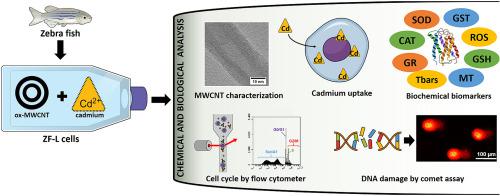Ecotoxicology and Environmental Safety ( IF 6.2 ) Pub Date : 2020-06-24 , DOI: 10.1016/j.ecoenv.2020.110892 Mariana Morozesk 1 , Lidiane S Franqui 2 , Fernanda C Pinheiro 3 , Joaquim A Nóbrega 3 , Diego S T Martinez 2 , Marisa N Fernandes 1

|
Carbon nanotubes presence in the environment increases every year because of exponential industrial production around the world. In aquatic environments, carbon nanotubes can interact with other pollutants based on their adsorbent surface chemistry properties. Heavy metal ions represent one of the biggest concerns in water resources nowadays due to anthropogenic activities, in which cadmium (Cd) is one of the most harmful metal for aquatic organisms. This study investigated the influence of two co-exposure protocols differing by the order of interaction of oxidized multiwalled carbon nanotubes (ox-MWCNT) with Cd in zebrafish liver cell line (ZFL). The ox-MWCNT was characterized, Cd content in culture medium and uptake by cells were quantified using ICP-MS and, the reactive oxygen species (ROS), the biotransformation enzymes activity of phase I and II as well as the antioxidants defenses and oxidative damage were analyzed. The effects on the cell cycle were investigated by flow cytometry and DNA damage by comet assay. The exposure to ox-MWCNT alone decreased the activity of catalase, glutathione peroxidase, and glutathione S-transferase and altered the cell cycle with a reduction of cells in the G2/M phase. Cd exposure alone decreased the activity of catalase and glutathione S-transferase, increased ROS, metallothionein, and lipid peroxidation content and causes genotoxicity in the cells. Despite different incubation protocol, the co-exposure ox-MWCNT-Cd increased the Cd content in ZFL cells after 24 h exposure, increased ROS production and DNA damage without differences between them. Our results showed the modulation of ox-MWCNT on Cd effects and contributed to future co-exposure toxicity investigations and nanosafety regulations involving carbon nanomaterials and aquatic pollutants.
中文翻译:

多壁碳纳米管与镉共同暴露对斑马鱼细胞系的影响:金属摄取和积累,氧化应激,遗传毒性和细胞周期。
碳纳米管在环境中的存在每年都在增加,这是因为全世界的工业生产呈指数级增长。在水生环境中,碳纳米管可以根据其吸附剂的表面化学性质与其他污染物相互作用。由于人为活动,重金属离子是当今水资源中最令人关注的问题之一,其中镉(Cd)是对水生生物最有害的金属之一。这项研究调查了两种共同暴露方案的影响,它们的区别在于斑马鱼肝细胞系(ZFL)中氧化的多壁碳纳米管(ox-MWCNT)与Cd相互作用的顺序。表征了ox-MWCNT,使用ICP-MS对培养基中Cd含量和细胞吸收进行了定量,并且活性氧(ROS),分析了I相和II相的生物转化酶活性,以及抗氧化剂的防御和氧化损伤。通过流式细胞术和彗星试验检测DNA损伤对细胞周期的影响。单独暴露于ox-MWCNT会降低过氧化氢酶,谷胱甘肽过氧化物酶和谷胱甘肽S-转移酶的活性,并改变细胞周期,减少G2 / M期的细胞。单独的镉暴露会降低过氧化氢酶和谷胱甘肽S-转移酶的活性,增加ROS,金属硫蛋白和脂质过氧化含量,并在细胞中引起遗传毒性。尽管有不同的温育方案,但在暴露24小时后,共同暴露ox-MWCNT-Cd会增加ZFL细胞中的Cd含量,增加ROS的产生和DNA损伤,而两者之间没有差异。











































 京公网安备 11010802027423号
京公网安备 11010802027423号